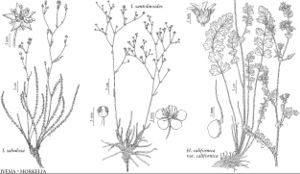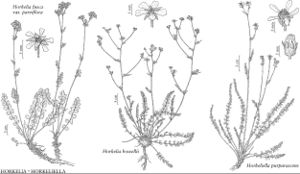Horkelia
Linnaea 2: 26. 1827.
Herbs, perennial, rosetted, tufted, or matted, often resinously aromatic, 0.3–10 (–12) dm, sparsely to densely hairy, inconspicuously to conspicuously glandular; compactly to ± loosely rhizomatous. Stems 1–10+, decumbent to erect, rarely prostrate, green, reddish, or stramineous. Leaves marcescent or winter-persistent, primarily basal, cauline 1–6 (–10), gradually or abruptly reduced distally, alternate, odd-pinnate; stipules persistent, basally adnate to petiole, linear to lanceolate or elliptic, margins entire or pinnately divided into linear to filiform segments; petiole present; blade oblanceolate-oblong to linear in outline, planar to cylindric, (1–) 2–30 (–40) cm, foliaceous, leaflets (3–) 5–41, separate or congested and overlapping, terminal usually ± confluent with distalmost lateral ones, elliptic-oblong to ovate or flabellate in outline, margins flat, shallowly toothed to deeply divided into oblanceolate lobes, sometimes nearly entire except for 3-toothed apex, rarely completely entire, venation palmate to pinnate. Inflorescences terminal, 3–200-flowered, open to congested cymes, flowers arranged individually, in corymbiform clusters, and/or in ± globose glomerules, these sometimes capitate; bracts present at proximal nodes, ± leafy, becoming reduced distally; bracteoles absent. Pedicels present, usually straight in fruit, sometimes reflexed or recurved. Flowers 4–17 mm diam.; epicalyx bractlets 5; hypanthium ± cupulate with flattened bases, 1–5.5 mm, less than 1/2 to nearly as deep as wide, interior often with band of hairs; sepals 5, spreading to strongly reflexed, usually lanceolate, sometimes ovate to triangular; petals 5, usually white, sometimes pink to rose-veined or cream, usually narrowly oblanceolate-elliptic to obovate, sometimes linear to round, usually equal to or longer than sepals; stamens 10, shorter than petals, filaments usually ± erect, ± flattened, forming tube, anther thecae dehiscing introrsely; torus conic; carpels 2–200 (–220), glabrous, styles subterminal; ovule 1. Fruits aggregated achenes, (1–) 2–200 (–220), obliquely ovoid to reniform, 0.8–3 mm, glabrous; hypanthium persistent; sepals persistent, erect; styles tardily deciduous, jointed, usually ± rough-thickened basally, otherwise mostly filiform. x = 7.
Distribution
w North America, nw Mexico
Discussion
Species 20 (20 in the flora).
As discussed under 9. Ivesia, recognition of the ivesioid genera including Horkelia results in a paraphyletic Potentilla, which the first author does not find sufficient to dictate generic circumscriptions. On the basis of morphology and biogeography, Horkelia itself is likely nested within Ivesia as the branch that has radiated primarily within the California Floristic Province (see discussions under Ivesia regarding discordance with M. Töpel et al. 2012, http://www.plosone.org/article/info%3Adoi%2F10.1371%2Fjournal.pone.0050358). Ivesia in the strict sense consists of an exceptionally diverse array of well-defined species; in contrast, Horkelia is more morphologically coherent as a genus but with species less sharply defined. The primary unifying features of the genus result from a flower specifically adapted for bee pollination: a relatively deep, flat-bottomed hypanthium containing abundant nectar, to which access is restricted by the columnar arrangement of ten erect stamens with flattened filaments, at least in early flowering. Anthers open introrsely by adaxial slits so that pollen is deposited on a visitor forcing its way into the staminal column.
Other diagnostic characteristics of Horkelia include a distinctive resinous aroma in most species (except sect. Tridentatae and sect. Hispidulae) and various levels of glandularity. The terminal leaflet is most often lobed and/or confluent with lateral leaflets, in contrast to Drymocallis, which is often confused with Horkelia. Leaves range from planar with distinct leaflets to cylindric with overlapping leaflets, the latter condition often a response to drought stress in species that are normally planar-leaved. Sepals are often strongly reflexed.
Stem lengths given below include inflorescences. Leaflet descriptions are based primarily on mid rachis leaflets of the larger basal leaves present at flowering; leaflets on the smaller outermost leaves formed early in the growing season are often less divided and less hairy. Counts of leaflet marginal segments include both shallow (teeth) and deep (lobes) ultimate divisions. Flowers are often aggregated into a single corymbiform cluster or one to many more globular glomerules, some of which are tightly capitate. Hypanthia interiors are glabrous in most species, except for the hairs surrounding the torus; some taxa are also more or less pilose on the internal hypanthial walls, especially just below the rim. Sepals are described as spreading or reflexed based on their orientation at anthesis. Larger and smaller anthers often are alternating; measurements are primarily of the larger filaments, with width measured at the base. See under 8. Potentilla and 9. Ivesia for additional discussion of special terminology.
Selected References
None.
Lower Taxa
Key
| 1 | Pedicels becoming reflexed or recurved, 3–15 mm; inflorescences open; Sierra Nevada foothills and San Bernardino Mountains, California. | Horkelia sect. Parryae |
| 1 | Pedicels remaining straight, outermost sometimes ± reflexed in congested inflorescences, 1–30(–40) mm; inflorescences open to congested; w United States | > 2 |
| 2 | Basal leaves: leaflet teeth (0–)3(–5), restricted to apex, leaflets 2–5 per side. | Horkelia sect. Tridentatae |
| 2 | Basal leaves: leaflet teeth or lobes (0–)4–30(–60), not restricted to apex, leaflets (1–)3–16(–20) per side | > 3 |
| 3 | Plants not resinously aromatic, inconspicuously to moderately glandular; basal leaves ± cylindric to weakly planar; leaflets ± overlapping at least distally, divided 1/2–3/4+ to midrib into (0–)2–8(–15) lobes | > 4 |
| 3 | Plants ± resinously aromatic, conspicuously to obscurely (and minutely) glandular; leaves usually ± planar, sometimes nearly cylindric; leaflets separate to ± overlapping especially distally, divided ± 1/6–3/4+ to midrib into (3–)5–30(–60) teeth or lobes | > 5 |
| 4 | Plants forming dense mats; stems 0.3–2.5 dm; basal leaves: stipules entire; 2000–3400 m; White Mountains, s Sierra Nevada, and Siskiyou Mountains, California, w Nevada, sw Oregon. | Horkelia sect. Hispidulae |
| 4 | Plants forming rosettes or tufts, sometimes loose mats; stems 0.5–5 dm; basal leaves: stipules entire, forked, or pinnately divided into linear or filiform lobes; 60–2500 m; nw California, sw Oregon. | Horkelia sect. Tridentatae |
| 5 | Epicalyx bractlets narrowly elliptic-lanceolate to broadly ovate, 0.5–3 mm wide; pedicels 1–30(–40) mm; flowers arranged individually, in usually non-capitate glomerules, and/or in corymbiform clusters; Sierra Nevada foothills and w California. | Horkelia sect. Horkelia |
| 5 | Epicalyx bractlets linear, 0.2–0.3(–0.5) mm wide; pedicels 1–3(–10) mm; flowers usually arranged in ± capitate glomerules, rarely individually (in H. fusca var. filicoides); Sierra Nevada, California, to Washington and Wyoming. | Horkelia sect. Capitatae |
"thin" is not a number."dm" is not declared as a valid unit of measurement for this property.

